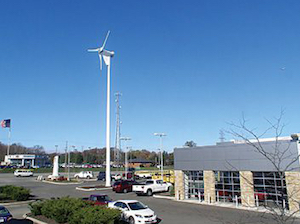By, Mick Sagrillo January 31, 2016

You’ve done your research on wind energy and fully understand the concepts of fuel quality and quantity, and the importance of tower height. It’s time to start looking around for what different manufacturers offer. So, what do you need to consider when perusing various small wind web sites? The following are good fundamentals to keep in mind when shopping for any wind energy conversion system.
Rotor size matters
The three (or sometimes two) blades attached to the hub make up the wind turbine “rotor”. The rotor is the “collector” for a wind turbine, collecting wind energy and converting it to rotational momentum that turns a generator and generates electricity. The bigger the collector, the more wind energy the system can collect and the more electricity it will generate. This is such a simple rule of physics that any child understands it, yet it seems to befuddle the gullible. Just as you cannot catch a lot of fish with a little net, you cannot power your entire house with a wind turbine sporting a small rotor.
Lesson: the output of a wind turbine is directly proportional to the size of the rotor.
Wind turbine “power” doesn’t matter
There are manufacturers selling wind turbines with small rotors driving generators with very high power ratings. As consumers, we’re impressed with what we perceive as power, regardless of what is delivered. Sales and marketing people know how to capitalize on this infatuation. In addition, it seems easy to compare products based on their power rating.
Enter the small rotor driving a large nameplate generator. The unsuspecting buyer jumps to the conclusion that such a device will “power” their entire house. However, your house doesn’t use power or kilowatts (kW). It uses energy, which we measure in kilowatt hours (kWh). What you need to look for is the amount of energy (kWh) that each wind turbine you are interested in will produce at the conservatively estimated average annual wind speed that you hope exists at the top of the appropriately tall enough tower you need to install at your site.
Lesson: the power of the generator doesn’t matter, it’s the wrong metric for making a purchasing decision on. However, the kilowatt hours generated at your site’s tower height does. After all, isn’t that why you’re buying a wind turbine? What’s really important in generating kWh with a small wind turbine is the swept area of the rotor, not the size of the generator.

Technological breakthroughs simply are not
Any number of manufacturers tout their new designs as “technology breakthroughs”, Just as frequently, the designers boost that they were “thinking outside the box” when conceiving their new design.
Successful wind turbine designs are based on established physics principles and sound engineering. The commercially viable wind turbines that have been around for a decade or more have succeeded where others have failed because they have built or improved, incrementally, on designs that work. They have evolved over time, their manufacturers learning from their and others’ mistakes. Coming up with something that looks different is not rocket science. However, manufacturing a small wind turbine that delivers as promised takes more than just coming up with a unique rotor design and marketing hype.
Lesson: self-proclaimed “technological breakthroughs” are all too often merely public relations marketing ploys designed to sell a new wind turbine design that cannot, and will not, generate more electricity than the current tried and true designs that are successful in the marketplace. Evolution, not revolution, has proven itself over and over again in the small wind industry. Just as you cannot catch a lot of fish with a little net, you cannot power your entire house with a wind turbine sporting a small rotor. Copyright © 2014 American Solar Energy Society. All rights reserved. SOLAR TODAY WINTER 2015 / 2016 29 Don’t put any small wind turbine on your shopping list that doesn’t carry one of these two logos.
Certification really matters
In 2009, the American Wind Energy Association adopted the Small Wind Turbine Performance and Safety Standard after years of development by the small wind industry. The AWEA 9.1 Standard mirrors the IEC standard for small wind turbines with some modifications. The voluntary testing and subsequent certification is intended to enable consumers and funding agencies to compare products and turbine performance, and to be assured that the manufactures have done their due diligence to ensure their product’s safety.
The AWEA 9.1 Standard includes a power performance test, acoustic sound test, safety & function test, and duration test. Once testing has been successfully completed and documented, the results are confirmed by a certification agency, then posted on web sites such as the Small Wind Certification Council (SWCC) at http://smallwindcertification. org/certified-small-turbines/ or Intertek at http://www.intertek.com/wind/directory/ along with the certification that has been attained.
Public benefits programs, funding agencies, and the IRS nearly universally require AWEA 9.1 certification as a prerequisite for grant or tax credit applications. Certification should be a paramount consideration to purchasing a turbine that has at the very least undergone independent review of engineering and testing documentation.
Lesson: If a small wind turbine you are considering is not certified to the full (not partial) AWEA 9.1 Standard, or if a medium wind turbine does not have a comparable certification (see http://smallwindcertification. org/certified-medium-turbines/), then seriously reconsider why you are even thinking of making such a purchase. Better yet, walk on by and don’t look back regardless of any promises the manufacturer makes. The only guarantee you have that the manufacturer has done any due diligence in design and testing at all is certification to the AWEA 9.1 Standard.




